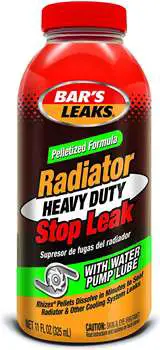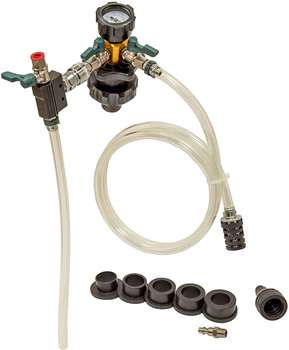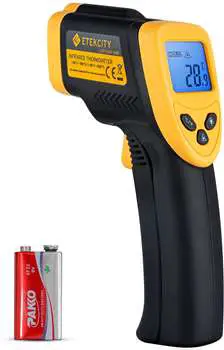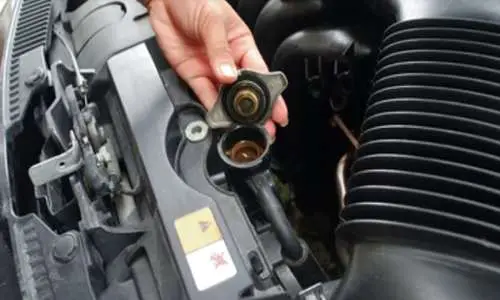
The poor functioning of a cooling system can damage the car engine. Thus, the fix could be to get your entire engine replacement. Therefore, an appropriate and running coolant system in a car is extremely important.
It is because it serves major purposes. Firstly, it removes the excessive heat from the engine to avoid engine overheating. Secondly, it depends upon the cooling system to analyze and maintain the engine operating temperature at which it works most efficiently.
How to know that your car has air in the coolant system? The presence of air is the most common reason for malfunctioning. However, most people still face difficulty in suspecting its presence.
Let me tell you, the common symptoms of air in your coolant system are engine over-heating and your heater won’t work.
How to Tell if Air in Cooling System?
Two of the main air in radiator symptoms. One comes in the form of car overheating while driving, and the other is that your heater won’t work. Now let’s get into more symptoms of air in the cooling system.
Air in Coolant System Symptoms are:
- Car Overheating while Driving
- Heater not Blowing Hot Air in Car
- Hear water Gushing Sound inside Dashboard
Car Overheating while Driving
A malfunctioning cooling system causes the car to overheat while driving. But how does it actually happen? When the air gets trapped inside the cooling system, it causes the system to overheat.
The air bubble which gets trapped in the temperature sensor makes it nearly impossible for the sensors to report the accurate temperature. The sensor displays a lower temperature, which does not let the fan and cooling system turn on.
But here’s another case as well! If the air bubble gets trapped in the thermostat, it will not open until the temperature gets really high.
The core idea behind the cooling system is to regulate the temperature and heat level by allowing them to fluctuate. However, temperature spikes are the aspects of a flawed cooling system.
Heater not Blowing Hot Air in Car
Another cue to understand the presence of an air bubble in the coolant system is a nonfunctional car heater. You can easily come to know about this!
When you turn on the car heater, you would not be getting any heat coming out of the air vents. The air sockets would not be pushing hot air into the car interior.
When the air trapped in cooling system, it prohibits hot fluid from going to the heater core. That is why, when you turn on the car heater, it doesn’t give hot air.
Hear water Gushing Sound inside Dashboard
A lot of people complain “I hear water in my dashboard!” This sounds intriguing! But here’s a reason why does it happen.
It begins with the presence of an air pocket in the cooling system of the engine. Thus, if you hear the same noise, it is due to this air trap.
When you start the car, the coolant gets pumped through the heater core resulting in a gushing sound inside the Dashboard. But how to get rid of it?
It is important to make sure that the radiator is completely full. If there is any air inside the system, it needs to be let out from the system. For this purpose, certain vehicles have special valves as well.
What Happens if There is Air in the Coolant System?
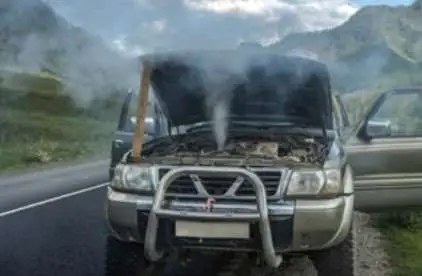
When there remains trapped air inside the coolant system, it doesn’t allow passage to the coolant. It keeps the coolant from reaching the critical components of an engine. The cylinder head is one such example of critical components and thus increases the risk of car over-heating.
Some vehicles have special bleeder valves to release such trapped air. Trapped air in such circumstances can cause hot spots in the engine.
Despite the coolant level not being low, a hot spot can damage several parts of the engine. This may include failed gaskets or moving parts of the engine.
Now, Let’s Talk about Different Causes which produce Air Bubbles in Coolant System
What Causes Air Bubbles in Radiator?
There are three factors which causes air bubbles in your radiator or coolant system, these are leaking head gasket, radiator hose leak, and bad radiator cap. Read ahead to know more about them!
Leaking Head Gasket
If air bubbles are appearing in the radiator, it must be because air is somehow coming from a pressurized system.
Even a minimal leakage in the head gasket allows a passage to the combustion gases. Consequently, the gasses from the cylinder engine reach into the car coolant system and results in producing air bubbles in the radiator.
If you see a constant stream of bubbles, it is probably due to a blown head gasket. But, somehow, there’s nothing to worry about. You can easily fix the issue by using Pelletized HD Radiator Stop Leak.
It is efficient for sealing small leaks and conditioning of cooling system. However, for larger leaks, you need to reconsider the choice. See the latest price of Bar’s Leak.
Radiator Hose Leak
Well, here’s another common cause of air in the radiator. It has been noticed that bubbling in the radiator could be due to a leaking hose. A leaky hose draws air into the coolant tank resulting in air bubbles.
So, one can presume a leak that is letting air in can also let the coolant out. So if you see a puddle of coolant under your car, then it might be due to a radiator hose leak.
Bad Radiator Cap
Another possible reason might be a loose or a bad radiator cap. If the bubble starts building up only when the engine is hot, the radiator cap is likely to be the problem.
It is because a loose or unfit radiator cap does not maintain proper pressurization of the radiator. So, check the radiator cap or replace it with a new one to resolve the problem.
However, if you are in doubt, borrow from a friend to check if the cap is at fault or not.
How to Burp a Cooling System?
Place a funnel at the radiator opening and completely fill the coolant in it. Next, start the engine and race it up until fan start running. The step-by-step guide of how to burp a cooling system without a radiator cap is as follows:
Start by parking the car on some level surface. This step can make the process of letting air out of the system somewhat easier.
Next, get in your car and set the heater to the maximum. This can help the air bubble move out of the air cord that is causing you no heat issue. If you have mechanical control, then turn on your fan.
Open the radiator cap and place the funnel at the opening. Just place the funnel at the opening of the radiator and push it down with a bit of pressure so that it stays in its place.
Slowly begin with adding coolant into the funnel. However, stop adding more of it right when you see some of the coolants at the bottom of the funnel.
It is important because once you start the car to remove air, the coolant would rise in the funnel, and there would be a risk of overflowing.
Now before starting the car, squeeze radiator hoses because sometimes these can allow you to add more of the coolant. Once done, the next step is to turn on the engine.
Now, after the engine keeps on running, the coolant level will drop. You would have to add more coolant but make sure not to go overboard and be very slow.
Now again squeeze both, upper and lower radiator hoses because it’s going to get the air bubble out of your cooling system.
Another thing you can do to remove the air bubble is to race your engine up and done. Keep repeating the steps until your cooling fans turn on and off twice.
This will take up approximately 15-20 minutes. In order to double-check, touch both radiator hoses. If they feel alike and at the same temperature to touch, that means the thermostat is now working.
The next step is to remove the funnel. Be very careful because all the coolant in it would be really hot. Thus maintaining appropriate care, remove it from the car. That’s how simple it is to burp a cooling system.
Some of the tools that can further assist you with the process are
Coolant Vacuum Refill Kit
Instead of using a non-reliable funnel, you can use this kit to refill the radiator’s coolant. This kit helps you quickly eliminate trapped air, and test radiator and heating core lines for leaks. Click Here to see the latest price.
Infrared Thermometer
Another tool that can help you save time is an infra-red thermometer. Despite risking your hands, this tool can help you in measuring temperature by distance.
Think about saving both time and energy by using an infrared thermometer, which is more efficient in accuracy and comes with a versatile design indeed. Click Here to see the latest price.

